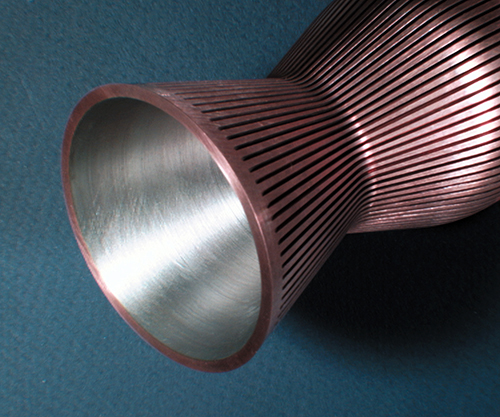A New Way to Spray
An idea that started around the dining room table of Plasma Processes, Inc.'s president Tim McKechnie has blasted off with the assistance of the NASA Marshall Space Flight Center. Working with Marshall on a Small Business Innovation Research (SBIR) contract, Plasma Processes developed Vacuum Plasma Spray (VPS) nozzles to be used in applying coating materials.
Plasma spraying has long been used to provide coatings of heat or wear resistant material onto a substrate. Typically these coatings extend the life of the coated object and improve strength and resistance to corrosion and heat. Rocket engines are a classic example of an item traditionally receiving a plasma spray coating to withstand rapid temperature changes. Plasma spray techniques have recently been used to build up a thick coating of material over a preformed mold, allowing the plasma spray to form a part net shape.
Designed for thermal spray applications, Plasma Processes' patented nozzles use a bell-contoured design that is superior to traditional conical nozzles. The result is a purer stream without the shock waves and expansion fans that occur with traditional nozzles. Shock waves and expansion fans create a problem that plagues plasma spray nozzles--overspray. Overspray occurs when powder escapes the plasma flow prior to deposition on the targeted substrate. In order to correct overspray, ideal flow expansion is required at the nozzle exit. Ideal flow expansion occurs when the pressure of the exiting plasma is the same as the ambient pressure around the nozzle.
Plasma Processes' bell-shaped nozzle creates an ideal flow expansion and virtually eliminates shock waves and expansion fans, reducing overspray significantly. Conical shaped nozzles can see as much as 10 percent of the intended coating lost to overspray. By using the bell-shaped design, overspray is reduced by at least 50 percent. This results in a significant decrease in the cost of the plasma spray process. In addition, the quality of the finished coating is greatly improved. Further cost savings are realized with the newly designed nozzles improved coating efficiency. By increasing the coating efficiency, the plasma spray process takes less time to complete a job. Reducing overspray also improves the quality, purity, and integrity of the coating. The result is a longer lasting coating.
Each nozzle is custom designed specifically for the material used and the required flow rate. Plasma Processes offers the nozzles for sale, as well as plasma spray coating services at their facilities. NASA makes use of the nozzle for projects such as spray forming crystal growth furnaces cartridge tubes in microgravity research, and advanced propulsion thrust chambers. According to McKechnie, without NASA's backing, the nozzle would still be an idea.
From its humble beginnings around the dining room table, Plasma Processes has expanded to occupy 24,000 square feet of space in their plasma spray facility. Plasma Processes has a client list from around the world and can offer the same services to anyone, from a private inventor to NASA.

The bell-shape of Plasma Processes' plasma spray nozzle reduces overspray, increasing the speed of plasma spraying while reducing costs.













